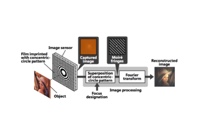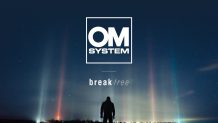Focus can be adjusted anytime to objects requiring attention, Hitachi said, adding it is aiming to utilize this technology in a broad range of applications such as work support, automated driving, and human-behavior analysis, vehicles and robots as well as cameras mounted on mobile devices. Post-capture focus is already available with light-field cameras that record position and direction of light beams simultaneously, but they are considerably thick since they need a special lens. A lensless camera, on the other hand, can be designed much thiner and lighter.
Hitachi’s new camera technology is based on the principle of Moiré fringes that are generated from superposition of concentric circles. A film patterned with concentric circles (whose interval narrow toward the edge of the film) is positioned in front of an image sensor, and the image of a shadow formed by a light beam irradiated onto the film is captured by the image sensor. During the image processing, a similar concentric-circle pattern is superimposed on the shadow and Moiré fringes with spacing dependent on the incidence angle of a light beam are formed. By utilizing the Moiré fringes, it is possible to capture images by simple and commonly used image processing called “Fourier transform”.
The focal position can be dajusted by changing the size of the concentric-circle pattern superimposed on the shadow formed on the image sensor by a light beam irradiated onto the film. By superposing the concentric-circle pattern by image processing after image capturing, the focal position can be chosen freely, according to Hitachi. To measure the performance of the new technology, an experiment with an 1 sq. cm large image sensor and a film imprinted with a concentric-circle pattern positioned 1 mm from the sensor was conducted. The results of the experiment confirmed that video images could be captured at 30 frames per second when a standard notebook PC was used for image processing.






